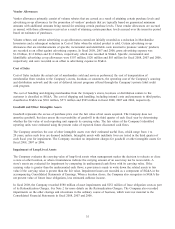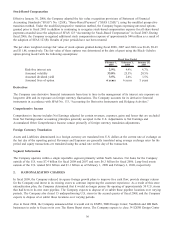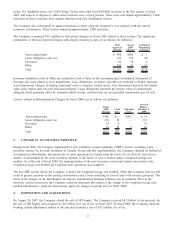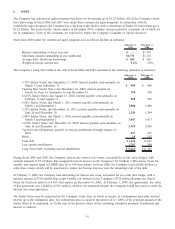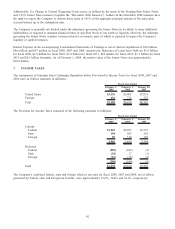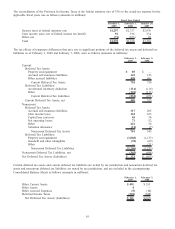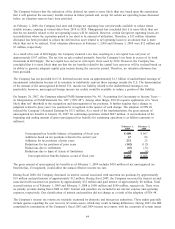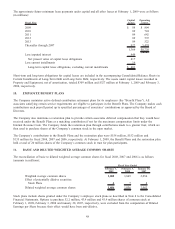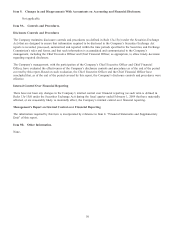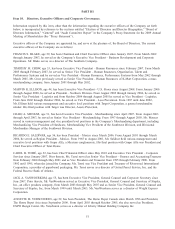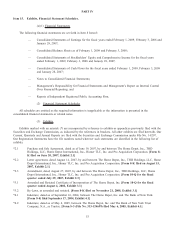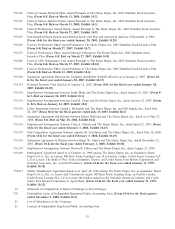Home Depot 2008 Annual Report Download - page 50
Download and view the complete annual report
Please find page 50 of the 2008 Home Depot annual report below. You can navigate through the pages in the report by either clicking on the pages listed below, or by using the keyword search tool below to find specific information within the annual report.that are currently under appeal. During 2008, the IRS began its examination of the Company’s U.S. federal income tax
returns for fiscal years 2005 and 2006. The Canadian governments, including various provinces, are currently auditing
income tax returns for the years 2004 through 2005. Also, during 2008, the company entered into an Advance Pricing
Agreement which settled a transfer pricing issue for the years 2004 through 2008 related to intangible assets provided
from the U.S. There are also ongoing U.S. state and local audits covering tax years 2001 to 2006. At this time, the
Company does not expect the results from any income tax audit to have a material impact on the Company’s financial
statements.
The Company believes that certain adjustments under appeal for the completed IRS examination, as well as certain state
audits, will be agreed upon within the next twelve months. The Company has classified approximately $18 million of the
reserve for unrecognized tax benefits as a short-term liability in the accompanying Consolidated Balance Sheets. Final
settlement of these audit issues may result in payments that are more or less than these amounts, but the Company does
not anticipate the resolution of these matters will result in a material change to its consolidated financial position or
results of operations.
8. EMPLOYEE STOCK PLANS
The Home Depot, Inc. 2005 Omnibus Stock Incentive Plan (“2005 Plan”) and The Home Depot, Inc. 1997 Omnibus Stock
Incentive Plan (“1997 Plan” and collectively with the 2005 Plan, the “Plans”) provide that incentive and non-qualified
stock options, stock appreciation rights, restricted shares, performance shares, performance units and deferred shares may
be issued to selected associates, officers and directors of the Company. Under the 2005 Plan, the maximum number of
shares of the Company’s common stock authorized for issuance is 255 million shares, with any award other than a stock
option reducing the number of shares available for issuance by 2.11 shares. As of February 1, 2009, there were
205 million shares available for future grants under the 2005 Plan. No additional equity awards may be issued from the
1997 Plan after the adoption of the 2005 Plan on May 26, 2005.
Under the terms of the Plans, incentive stock options and non-qualified stock options are to be priced at or above the fair
market value of the Company’s stock on the date of the grant. Typically, incentive stock options and non-qualified stock
options vest at the rate of 25% per year commencing on the first or second anniversary date of the grant and expire on the
tenth anniversary date of the grant. Certain of the non-qualified stock options also include performance options which vest
on the later of the first anniversary date of the grant and the date the closing price of the Company’s common stock has
been 25% greater than the exercise price of the options for 30 consecutive trading days. The Company recognized
$47 million, $61 million and $148 million of stock-based compensation expense in fiscal 2008, 2007 and 2006,
respectively, related to stock options.
Restrictions on the restricted stock issued under the Plans generally lapse according to one of the following schedules:
(1) the restrictions of the restricted stock lapse over various periods up to five years, (2) the restrictions on 25% of the
restricted stock lapse upon the third and sixth anniversaries of the date of issuance with the remaining 50% of the
restricted stock lapsing upon the associate’s attainment of age 62, or (3) the restrictions on 25% of the restricted stock
lapse upon the third and sixth anniversaries of the date of issuance with the remaining 50% of the restricted stock lapsing
upon the earlier of the associate’s attainment of age 60 or the tenth anniversary date. The restricted stock also includes the
Company’s performance shares, the payout of which is dependent on the Company’s total shareholders return percentile
ranking compared to the performance of individual companies included in the S&P 500 index at the end of the three-year
performance cycle. Additionally, certain awards may become non-forfeitable upon the attainment of age 60, provided the
associate has had five years of continuous service. The fair value of the restricted stock is expensed over the period during
which the restrictions lapse. The Company recorded stock-based compensation expense related to restricted stock of
$109 million, $122 million and $95 million in fiscal 2008, 2007 and 2006, respectively.
In fiscal 2008, 2007 and 2006, there were 641 thousand, 593 thousand and 417 thousand deferred shares, respectively,
granted under the Plans. Each deferred share entitles the person to one share of common stock to be received up to five
years after the vesting date of the deferred shares, subject to certain deferral rights of the associate. The Company
recorded stock-based compensation expense related to deferred shares of $9 million, $10 million and $37 million in fiscal
2008, 2007 and 2006, respectively.
As of February 1, 2009, there were 2.5 million non-qualified stock options outstanding under non-qualified stock option
plans that are not part of the Plans.
45


